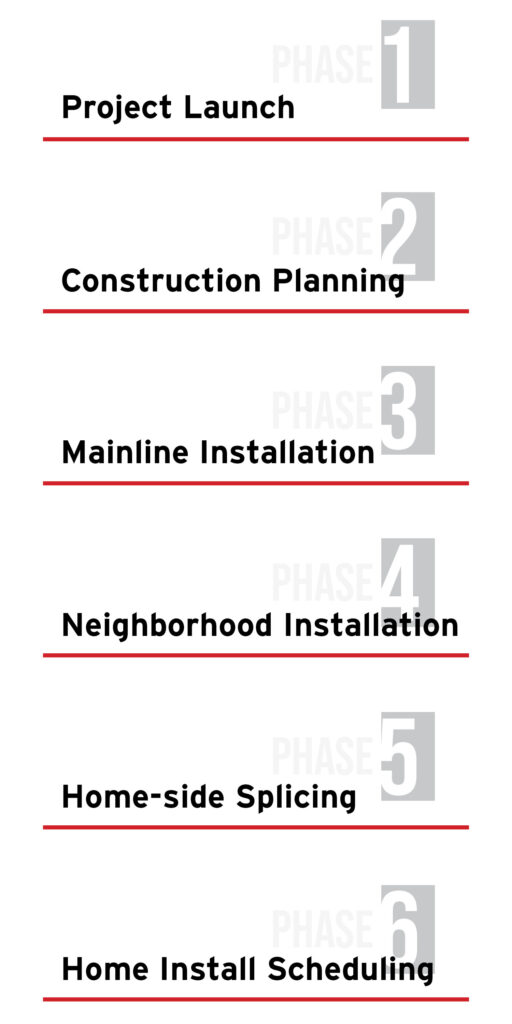Project Launch
During this stage, we release a public announcement and press release, then start the permitting process. Depending on the expected timeline of the specific project, we may launch pre-registrations on our website.
The terms we use:
- Permitting – Official approvals from local, state, or federal agencies before construction can begin.
- Pre-Registration – A way for customers to sign up early and show interest so we know who wants service first.
Construction Planning
Next, we finalize the detailed network design and complete utility locates. Construction is segmented into zones or phases, and materials are ordered and staged. We confirm the availability of contractors or in-house crews and develop a detailed construction schedule. Remaining permits are submitted as we finalize the locations of cabinets, splice vaults, and handholes.
The terms we use:
- Network Design – A detailed map of where fiber will be built in the community.
- Utility Locate – Checking where gas, water, power, and other lines are underground so crews don’t hit them.
- Zones/Phases – Breaking the project into smaller sections so service can roll out faster and more efficiently.
- Cabinet – A large outdoor box that houses the equipment needed to connect multiple homes.
- Splice Vault / Handhole – Underground access points where fiber cables are connected and maintained.
Mainline Installation
This phase, focused on both aerial and underground fiber placement, includes trenching, boring, conduit installation, strand placement, and fiber lashing for all the mainline fiber designated to connected electronics in cabinets and huts. Handholes, vaults, and splice enclosures are installed, and fiber is pulled through the conduit and terminated at splice points. Construction progress is monitored through inspections, followed by site cleanup and restoration.
The terms we use:
- Mainline Fiber – The “backbone” of the fiber network, running along main roads and carrying large amounts of data.
- Aerial Fiber – Fiber cables hung on poles above ground.
- Underground Fiber – Fiber cables buried in protective tubing beneath the ground.
- Trenching/Boring – Methods for digging or drilling to place underground fiber.
- Conduit – A plastic pipe that protects fiber cables underground.
- Fiber Lashing / Strand Placement – Attaching fiber cables securely to poles.
- Splice Enclosure – A protective case where fiber cables are joined together.
Neighborhood Installation
Much like mainline construction, this phase also focuses on aerial and underground fiber placement, and includes trenching, boring, conduit installation, strand placement, and fiber lashing for the streets and neighborhoods off the mainline. More precise handholes, vaults, and splice enclosures are installed, and fiber is pulled through the conduit and terminated at splice points. Again, construction progress is monitored through inspections, followed by site cleanup and restoration.
The terms we use:
- Neighborhood Fiber – Smaller fiber lines that branch off the mainline and run through residential streets.
- Restoration – Clean up and repair of lawns, roads, or sidewalks after construction.
Home-side Splicing
Drop fiber is spliced from the splitter to the terminal or home, with fusion splicing performed in handholes. Each drop is tested for signal strength, then labeled and documented. Any weak signals are identified and troubleshooted.
The terms we use:
- Drop Fiber – The fiber line that connects your home to the neighborhood fiber.
- Splitter – A device that splits a single fiber signal into multiple connections for different homes.
- Fusion Splicing – The process of “welding” two fiber cables together so light signals pass through seamlessly.
- Signal Testing – Checking to make sure your fiber line is strong and reliable before it’s connected.
Home Install Scheduling
Customers are notified that service is available, and scheduling is initiated. Drop fiber to each home is confirmed, technicians are scheduled for ONT and router installation, and a final system check is completed.
The terms we use:
- ONT (Optical Network Terminal) – A device installed in your home that converts the fiber signal into internet you can use.
- Router – The device that distributes Wi-Fi throughout your home.
- Final System Check – A test to make sure your internet is working correctly before the installation is finished.
